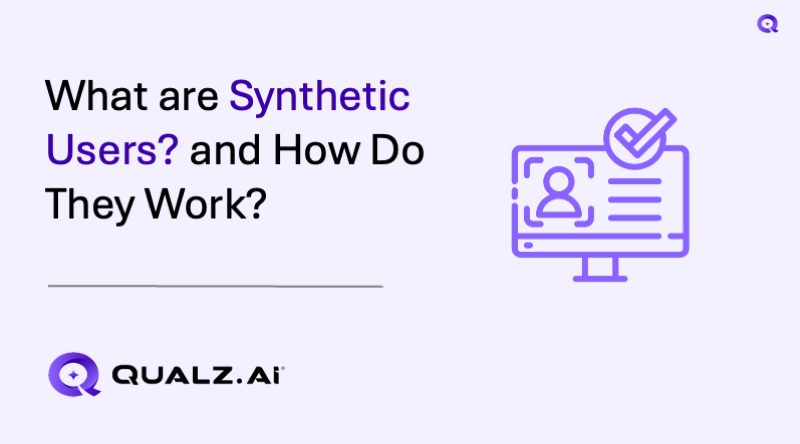Long before synthetic users entered the research scene, qualitative studies were dominated by in-depth interviews, focus groups, and manually collected responses that were rich in insight but slow, expensive, and often limited by recruitment logistics. Market researchers have always sought deeper understanding, but the cost of uncovering it has often been time and scalability. That changed with the rise of AI in research.
By 2023, early adopters began turning to AI-generated personas to simulate participants in interviews and surveys, providing feedback that was not only fast but also contextually intelligent. These weren’t generic chatbots. They were realistic, responsive, and increasingly indistinguishable from human respondents in early-stage research. This quiet revolution is now going mainstream, and researchers who embrace it are gaining a serious edge.
Topics Covered
ToggleIn this blog, we’ll break down exactly what synthetic users are and how they function within modern qualitative research. You’ll learn how they’re created, how they engage in studies, and why they’re becoming indispensable for research teams seeking to scale insight without compromising on depth or accuracy.
What Are Synthetic Users?
Synthetic users are AI-generated personas that simulate real human participants in qualitative research. They’re not just pre-programmed scripts, but they’re intelligent, dynamic responders capable of holding lifelike conversations, answering open-ended questions, and behaving in ways that mirror human decision-making.
These virtual participants are built using natural language processing and trained on diverse datasets to reflect realistic demographic and psychographic traits. Researchers can configure them based on age, background, behavior, and more, allowing for fast, targeted testing across multiple persona types.
As AI tools become more integral to platforms like Qualz.AI, synthetic users are being used to enrich studies where speed, diversity, and repeatability matter most. Especially in workflows that incorporate synthetic data to simulate real-world conditions, these AI participants provide a reliable and scalable solution.
How Do Synthetic Users Work?
The power of synthetic users lies in their flexibility and integration with intelligent research platforms.
Custom Persona Creation
Researchers begin by setting up user profiles, defining attributes like goals, values, or behaviors. The system then generates unique personas that match the target criteria. These profiles are particularly helpful when addressing hard-to-reach or niche segments.
Real-Time Interaction
Synthetic users can participate in studies just like real humans, responding in natural language to prompts in conversational surveys or engaging in AI-moderated interviews. Because their responses adapt in real time, they deliver rich qualitative data that’s ideal for thematic exploration.
Seamless Analysis Integration
What makes synthetic users so impactful is how easily they integrate with tools for automated analysis, transcription, and data visualization. Once the data is collected, AI can instantly organize, code, and surface key patterns, eliminating days of manual work.
By embedding synthetic users into these workflows, researchers accelerate every phase of the study from participant engagement to insight delivery.
Key Benefits of Using Synthetic Users in Research
As the demands on market researchers grow, synthetic users offer a new way to meet those demands with speed, precision, and scale. Here’s why they’re quickly becoming a standard in forward-thinking research teams:
Instant Access and Zero Scheduling Hassle
Synthetic users can be deployed on demand, eliminating the delays tied to recruiting and scheduling human participants. This makes agile testing cycles and same-day insights entirely possible.
Scalable and Cost-Efficient
Unlike traditional participants, synthetic users don’t require compensation or logistical coordination. Teams can scale their studies infinitely, reducing costs by up to 90% without sacrificing research quality.
Inclusive by Design
By customizing attributes like culture, language, or behavior, researchers can simulate a wide range of personas, unlocking inclusive research without the typical outreach limitations.
Consistency and Bias Control
Synthetic users provide consistent responses, free from human error or emotional variability. This is especially valuable when studying sensitive topics or maintaining uniform testing conditions across segments.
Native Integration with AI Tools
They work seamlessly with platforms offering dynamic surveys, adaptive interviews, and real-time analysis, amplifying the benefits of every other research tool in the stack.
Conclusion
Synthetic users aren’t just an efficiency hack; they represent a transformative evolution in how we conduct qualitative research. They offer a smarter, faster, and more scalable way to explore human insights without the constraints of traditional recruitment.
For market researchers ready to innovate, synthetic users offer a future where research is not only faster but also deeper, more inclusive, and dramatically more cost-effective. And as AI continues to advance, these digital participants will only become more realistic, responsive, and indispensable
